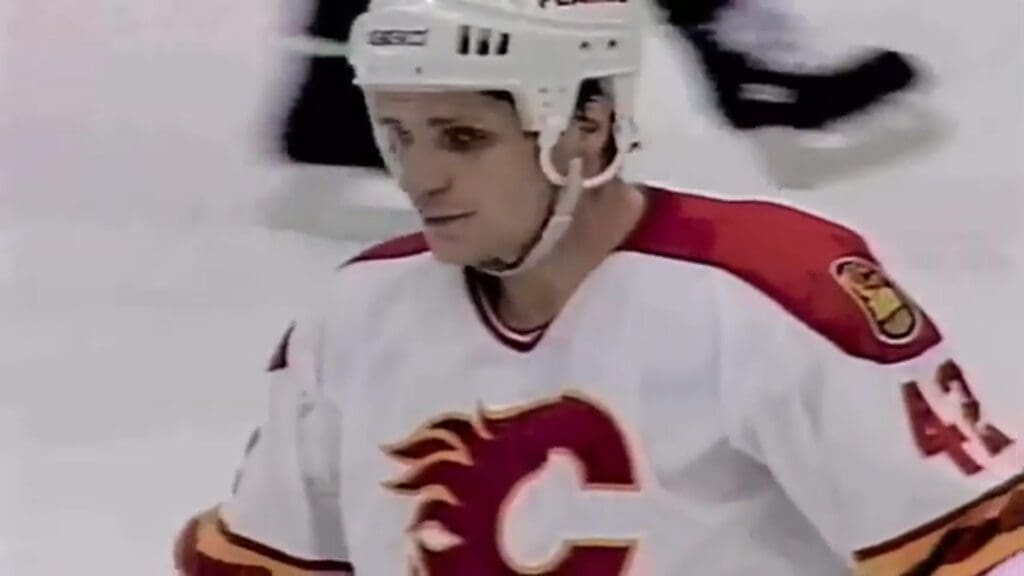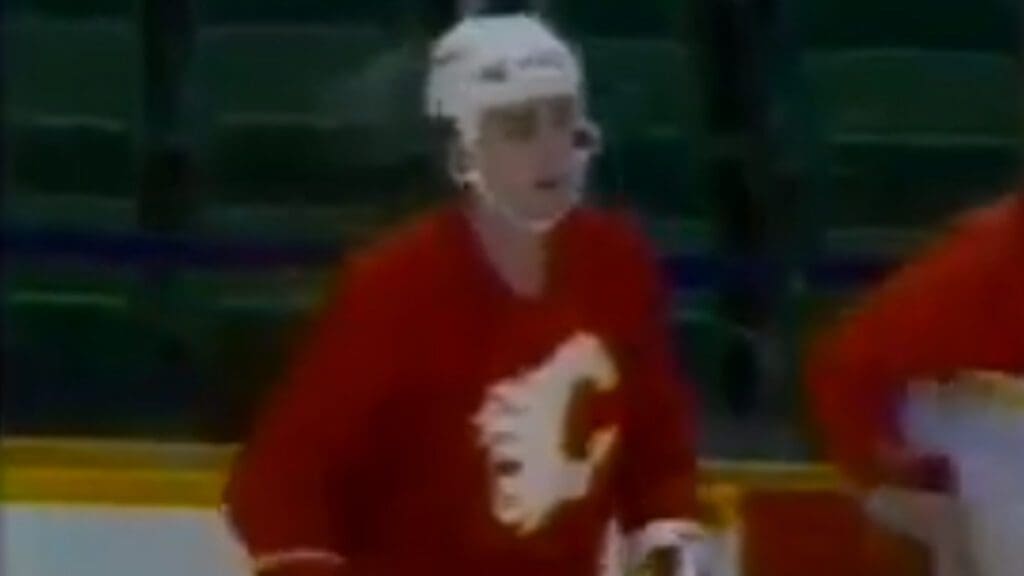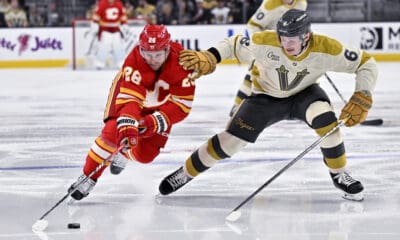Calgary Flames
Top all-time Flames draft picks: Rounds 10-12 Russian talent rush

The NHL Draft wasn’t always seven rounds long. Not even 20 years ago, the league held nine rounds of picking from a year’s worth of eligible players.
But before that, 12 rounds (and sometimes many more) were the norm, which is part of the reason why some clubs in the late 1970s and into the ’80s started taking fliers on seemingly untouchable dynamos behind the Iron Curtain of the times.
The Soviet bloc was producing top talent, world and Olympic champion-level players on par with their North American counterparts. The Canadian and U.S. hockey public witnessed them in the ’70s and ’80s through multiple summit series and national team/club exhibition tours through the NHL and the WHA.
Many of those players didn’t come over to play given the political climate at the time, but eventually, that didn’t stop NHL teams from using late-round picks on Soviet Bloc stars just in case relations between the East and the West warmed up enough to allow those players to go pro in North America.
The Calgary Flames got into the action by the early ’80s, taking Sergei Makarov with their 12th/final round pick in 1983.
Six years later, with Communism on the brink of collapsing in the Soviet world, the longtime, decorated national-team star was allowed to go to the other side of the world and sign with the Flames.
Following the selection of Makarov, the Flames would sometimes take a flier on a Russian player in the late rounds. The strategy worked out quite well for them as you will see.

Sergei Makarov with the Flames.
1. Sergei Makarov
1983: Round 12, 231st overall
Makarov, without question, is a hockey legend. He began his professional career in the Soviet Union in the late 1970s and quickly established himself as one of the game’s most talented forwards. He was an integral part of the so-called KLM Line alongside Vladimir Krutov and Igor Larionov, which was renowned for its offensive prowess.
Makarov’s exceptional speed, agility, and playmaking abilities made him a dominant force. He won numerous championships with CSKA Moscow and the Soviet national team.
As already mentioned, the Flames decided to use their last pick in the 1983 draft and take a chance on Makarov. Then-GM Cliff Fletcher told the Calgary Herald said a meeting he had with Soviet officials at that year’s world hockey championships convinced him to gamble on Makarov, who was by then considered by some to be the best player in the world and bestowed the nickname the Russian Gretzky in hockey circles.
And thanks to an NHL rule instituted in 1981 — since changed — all players drafted by a team remained on their reserve list indefinitely.
That 12th round pick worked out eventually.
In early March 1989, Makarov told Soviet media he was leaving the armed forces and the Red Army club and that he wanted to play for the Flames the next season.
And that’s what happened.
The cracks allowing movement of Russian players to North America started to show when the trailblazing Flames signed Sergei Priakin (more on him later) to a two-year-contract late that month. A little more than a month later, Alexander Mogilny — arguably the best and brightest upcoming Soviet star — defected to North America following a world championship win to join the Buffalo Sabres.
Then the floodgates opened. Makarov was a part of a wave of Soviet stars, including his Red Army linemates Krutov and Larionov and top defenceman Viacheslav Fetisov, that secured permission to play pro in the NHL starting in 1989-90. He signed with the Flames on July 1, 1989.
Despite joining the league relatively late in his career due to restrictions on Soviet players, Makarov made an immediate impact, finishing fourth in team scoring with 24 goals and 86 points in 80 games played then winning the Calder Memorial Trophy as the NHL’s top rookie in 1990 at age 31. His Calder win led the league to change its rules for the top-rookie trophy, capping the age of eligibility at 26.
The line of Makaov, Joe Nieuwendyk and Gary Roberts proved dynamite over Makarov’s time in Calgary. In his first year as a Flame, Makarov’s slick playmaking helped Nieuwendyk score 45 goals that season, Roberts 39. In the 1991-92 season that saw Roberts score 53 goals, Makarov assisted on 22 of them (starting with Roberts’ 14th goal of the campaign) after being reunited with him and Nieuwendyk in Game 23 of the 80-date schedule.
Makarov was productive over his four years in Calgary, scoring at a point-per-game pace the first three years before dipping slightly in 1992-93.
His playing days with the Flames ended on a sour note, though. Heading into Year 4 with the team, Makarov signed with the San Jose Sharks only to have Calgary match the four-year, $2-million contract. By the spring of 1993, he was in head coach Dave King’s doghouse. Makarov was scratched from 13 regular season games and watched all six Flames playoff games against the Los Angeles Kings that April from the press box. Calgary traded him to the Hartford Whalers a few days before the 1993 draft. Hartford promptly flipped him to San Jose.
Makarov spent the final two full seasons of his NHL playing days with the Sharks, ending in 1995. He attempted a comeback two seasons later with the Dallas Stars at age 38 but that was limited to four games.
| Season | Age | Tm | GP | G | A | PTS | +/- | PIM | SOG | S% |
| 1989-90 | 31 | Cgy | 80 | 24 | 62 | 86 | 33 | 55 | 118 | 20.3 |
| 1990-91 | 32 | Cgy | 78 | 30 | 49 | 79 | 15 | 44 | 93 | 32.3 |
| 1991-92 | 33 | Cgy | 68 | 22 | 48 | 70 | 14 | 60 | 83 | 26.5 |
| 1992-93 | 34 | Cgy | 71 | 18 | 39 | 57 | 0 | 40 | 105 | 17.1 |
| 1993-94 | 35 | SJS | 80 | 30 | 38 | 68 | 11 | 78 | 155 | 19.4 |
| 1994-95 | 36 | SJS | 43 | 10 | 14 | 24 | -4 | 40 | 56 | 17.9 |
| 1996-97 | 38 | Dal | 4 | 0 | 0 | 0 | -2 | 0 | 0 | |
| Career | 424 | 134 | 250 | 384 | 67 | 317 | 610 | 22 |
Off-season excitement
- Flames may be forced into rebuild
- Flames let soon-to-be-free-agent Lucic talk to other NHL teams
- Flames have chance to cash in on Hanifin

German Titov as a Flame.
2. German Titov
1993: Round 10, 252nd overall
Russian forward Titov was a 10th round selection by the Flames. This time, the pick came in unheralded fashion as Russian players coming to North America was an established practice by June 1993. Russians Mogilny and Vancouver Canucks superstar Pavel Bure were among the cream of the NHL elite scorers.
GM Doug Risebrough selected Titov 252nd overall in the final round. The winger, by then 27 and a veteran Russian product who lit up the Finnish pro league the season before, signed with the Flames just before training camp that fall.
He made the team, too, impressing coach King with his work ethic along the boards digging for the puck along with offensive punch. He played on a line with Joel Otto and Paul Ranheim to start and wound up with 27 goals and 45 points in 76 games played that season.
In all, Titov enjoyed five solid seasons as a Flame. Standout performances include five goals and eight points in seven games against the Sharks in the 1995 playoffs (although the first-round exit was definitely a disappointing team result given they had finished first in the Pacific Division) and a 28-goal, 67-point result in the 1995-96 regular season.
Titov and fellow winger Todd Hlushko were traded to the Pittsburgh Penguins for goalie Ken Wreggett and forward David Rochde in June 1998.
| Season | Age | Tm | GP | G | A | PTS | +/- | PIM | SOG | S% |
| 1993-94 | 28 | Cgy | 76 | 27 | 18 | 45 | 20 | 28 | 153 | 17.6 |
| 1994-95 | 29 | Cgy | 40 | 12 | 12 | 24 | 6 | 16 | 88 | 13.6 |
| 1995-96 | 30 | Cgy | 82 | 28 | 39 | 67 | 9 | 24 | 214 | 13.1 |
| 1996-97 | 31 | Cgy | 79 | 22 | 30 | 52 | -12 | 36 | 192 | 11.5 |
| 1997-98 | 32 | Cgy | 68 | 18 | 22 | 40 | -1 | 38 | 133 | 13.5 |
| 1998-99 | 33 | Pit | 72 | 11 | 45 | 56 | 18 | 34 | 113 | 9.7 |
| 1999-00 | 34 | TOT | 70 | 17 | 29 | 46 | -1 | 38 | 122 | 13.9 |
| 1999-00 | 34 | Pit | 63 | 17 | 25 | 42 | -3 | 34 | 111 | 15.3 |
| 1999-00 | 34 | Edm | 7 | 0 | 4 | 4 | 2 | 4 | 11 | 0 |
| 2000-01 | 35 | Ana | 71 | 9 | 11 | 20 | -21 | 61 | 78 | 11.5 |
| 2001-02 | 36 | Ana | 66 | 13 | 14 | 27 | 4 | 36 | 63 | 20.6 |
| Career | 624 | 157 | 220 | 377 | 22 | 311 | 1156 | 13.6 |
3. Jonas Hoglund
1992: 10th round, 222nd overall
The Flames took the Swedish winger in the 10th round of the 1992 Entry Draft. He played four more seasons with his hometown club Färjestads BK before joining the Flames for 1996-97, scoring 19 goals and 35 points in 68 games.
At the trade deadline the next season, he was traded to the Montreal Canadiens along with defenceman Zarley Zalapski for winger Valeri Bure and a draft pick.
Hoglund went on to play five more full NHL seasons, four of them with the Toronto Maple Leafs, before returning to Europe to play six more seasons of pro.
| Season | Age | Tm | GP | G | A | PTS | +/- | PIM | SOG | S% |
| 1996-97 | 24 | Cgy | 68 | 19 | 16 | 35 | -4 | 12 | 189 | 10.1 |
| 1997-98 | 25 | TOT | 78 | 12 | 13 | 25 | -7 | 22 | 186 | 6.5 |
| 1997-98 | 25 | Cgy | 50 | 6 | 8 | 14 | -9 | 16 | 124 | 4.8 |
| 1997-98 | 25 | Mtl | 28 | 6 | 5 | 11 | 2 | 6 | 62 | 9.7 |
| 1998-99 | 26 | Mtl | 74 | 8 | 10 | 18 | -5 | 16 | 122 | 6.6 |
| 1999-00 | 27 | Tor | 82 | 29 | 27 | 56 | -2 | 10 | 215 | 13.5 |
| 2000-01 | 28 | Tor | 82 | 23 | 26 | 49 | 1 | 14 | 196 | 11.7 |
| 2001-02 | 29 | Tor | 82 | 13 | 34 | 47 | 11 | 26 | 199 | 6.5 |
| 2002-03 | 30 | Tor | 79 | 13 | 19 | 32 | 2 | 12 | 157 | 8.3 |
| Career | 545 | 117 | 145 | 262 | -4 | 112 | 1264 | 9.3 |

Sergei Priakin in 1989.
4. Sergei Priakin
1988: 12th round, 252nd overall
I mentioned him before under Makarov’s entry. Priakin is a significant figure in Flames and NHL history because he was the first player given permission by the Soviet Union to seek pro hockey employment in North America in 1989.
The winger, 25 years old at the time, had been drafted by Calgary with the final pick of the previous year’s draft was signed by the Flames in late March 1989, playing two regular season games before the team went on its run to its fabled Stanley Cup victory.
While he made headlines that way, his hockey skills didn’t translate into success over his two full seasons with the Flames. He didn’t thrive in the checking role head coaches Terry Crisp and Doug Risebrough gave him.
While he did score a Cup ring in ’89, he didn’t score much else, recording three goals and 11 points in 46 NHL games played through the end of 1990-91. He also spent time in the press box and with the AHL Flames’ affiliate Salt Lake Golden Eagles.
With his contract expired, he returned to Europe the following season and capped his playing career in 2000.
| Season | Age | Tm | GP | G | A | PTS | +/- | PIM | SOG | S% |
| 1988-89 | 25 | Cgy | 2 | 0 | 0 | 0 | 1 | 2 | 2 | 0 |
| 1989-90 | 26 | Cgy | 20 | 2 | 2 | 4 | -7 | 0 | 17 | 11.8 |
| 1990-91 | 27 | Cgy | 24 | 1 | 6 | 7 | -3 | 0 | 26 | 3.8 |
| Career | 46 | 3 | 8 | 11 | -9 | 2 | 45 | 6.7 |

Andrei Trefilov in 1993.
5. Andrei Trefilov
1991: 12th round, 261st overall
It was either Trefilov or defenceman Greg Fox for the No. 5 spot. While Fox, drafted in the 11th round of the 1973 draft by the Atlanta Flames, went on to a robust career as a stay-at-home defenceman, his 494 career games spent patrolling NHL bluelines were mostly for the Chicago Blackhawks; just 80 of them were for the Flames.
Trefilov, while playing just 22 of his 54 career NHL games for Calgary, did so in two tours of backup duty for the Flames over four seasons.
Drafted in the 12th round of the 1991 draft, the former Soviet national team goalie unexpectedly signed with the Flames as a 23-year-old for 1992-93. Trefilov impressed the Flames at training camp that fall, but with Mike Vernon, Jeff Reese and Jason Muzzatti ahead of him and fellow rookie Trevor Kidd in the Calgary pecking order, Trefilov was sent to the AHL along with Kidd to start the year.
The crease only became more crowded in that era. Kidd supplanted Vernon as starter in that time, with Dwayne Roloson and Rick Tabaracci joining the mix later on.
Trefilov left the Flames as a free agent in the summer of 1995, signing a three-year, one-way deal worth almost $1 million per season with the Sabres to back up Dominik Hasek.
He returned to Calgary more than three years later when the injury-plagued Flames acquired him from the Chicago Blackhawks for a conditional draft pick. His second chance in Calgary was cut short by — surprise! — an injury and lasted just four games, going 0-3. After missing six games on the injured list, he was sent to the minors. After one more season of North American pro hockey with IHL Chicago, he left for Europe, where he played in Germany for six more years.
| Season | Age | Tm | GP | W | L | T/O | GA | SV% | GAA | SO | MIN |
| 1992-93 | 23 | Cgy | 1 | 0 | 0 | 1 | 5 | 0.872 | 4.62 | 0 | 65 |
| 1993-94 | 24 | Cgy | 11 | 3 | 4 | 2 | 26 | 0.915 | 2.51 | 2 | 623 |
| 1994-95 | 25 | Cgy | 6 | 0 | 3 | 0 | 16 | 0.877 | 4.07 | 0 | 236 |
| 1995-96 | 26 | Buf | 22 | 8 | 8 | 1 | 64 | 0.903 | 3.51 | 0 | 1094 |
| 1996-97 | 27 | Buf | 3 | 0 | 2 | 0 | 10 | 0.898 | 3.78 | 0 | 159 |
| 1997-98 | 28 | Chi | 6 | 1 | 4 | 0 | 17 | 0.883 | 3.41 | 0 | 299 |
| 1998-99 | 29 | TOT | 5 | 0 | 4 | 0 | 15 | 0.856 | 4.75 | 0 | 187 |
| 1998-99 | 29 | Chi | 1 | 0 | 1 | 0 | 4 | 0.8 | 9.7 | 0 | 25 |
| 1998-99 | 29 | Cgy | 4 | 0 | 3 | 0 | 11 | 0.869 | 4.01 | 0 | 162 |
| Career | 54 | 12 | 25 | 4 | 153 | 0.897 | 3.45 | 2 | 2663 |











